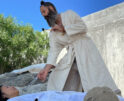
It Can Happen, A lot: Anterior Cruciate Ligament Tear: Surgical and Nonsurgical Treatments
You are sitting at the doctor’s office, hoping to get out of there as soon as possible, so you can make it to your next meeting and then he says: Your Anterior Cruciate Ligament (or ACL) is one of the pair of cruciate ligaments (the other being the Posterior Cruciate ligament) present in your knee… that’s the problem. ACL is a crucial ligament for providing the necessary crotational stability to the knee during turning or planting of the leg. Due to the daily stress on the ACL particularly in physically active people and athletes, it is prone to injuries such as the ACL tear, which is among the most common knee injury around the globe.
According to industry estimates, around 70 percent of the Anterior ligament tear in knee happen due to non-contact mechanism, while the remaining 30 percent occur during physical contact with another person or athlete.
Surgery for ACL tear is a common treatment method for this knee injury, with an estimated 100,000 ACL reconstructions performed every year around the globe. Besides surgical treatments, nonsurgical treatments for ACL tear, which include physical therapy and rehabilitation are also recommended for patients with knee injuries.
About ACL tear injuries. The decision to opt for either a surgical or nonsurgical treatment for ACL tear injuries depends on a variety of factors including the patient’s activity level, age, and the severity of the knee injury. Partially-torn ligament tear can be treated faster with recovery and rehabilitation lasting just around 3 months. Fifty percent of the ACL tears occur in combination to damages to other ligaments such as the meniscus and articular cartilage.
Additionally, ACL tear injuries are more common among women than men. ACL injuries are also common among children. For children under the age of 14, early ACL surgery have provided better results than a delayed surgery, while nonsurgical treatments are only recommended for children with open growth plates in the knee.
Surgical treatment. Surgical treatments or reconstruction of the ACL are most successful in the long term, with success rates of 82 to 95 percent. Only 8 percent of the patients who have undergone ACL surgeries have reported recurrent knee instability and graft problems post the treatment.
For adults, ACL surgeries are recommended based on the activity level of the patient, and not the age. Active individuals or athletes who are physically active with sports or heavy manual work that involves pivoting or turning are recommended to opt for surgical therapy. This can also include older patients, who have previously not undergone any surgical intervention.
Surgical treatments also produce better results for a combination of knee injuries including ACL.
Nonsurgical treatment? Nonsurgical treatments are recommended and likely to be more successful in patients with partial ACL tears or no knee instability symptoms, along with those who live sedentary lifestyles and are not involved in manual hard work. Nonsurgical treatment methods such as physical therapy and rehabilitation can restore the injured knee to its pre-injury state. Patients are also advised on the use of hinged knee brace to prevent instability episodes post the treatment.
However, many patients who opt for nonsurgical treatment, report secondary injuries to the knee after the treatment, caused by repetitive knee instability episodes.
While there are many hospitals that claim to have expertise in treating ACL tear injuries, ladies, be advised to compare hospitals online before deciding on the best treatment facility.
Recommended
-
You Need A Vacation!August 22nd, 2024
-
The Power Of Saying “No” W...March 22nd, 2024
-
Is It Time To Change Your Rela...March 20th, 2024
-
What’s Your Legacy?December 18th, 2023
-
Be Here Now—Two Easy StepsSeptember 19th, 2023















